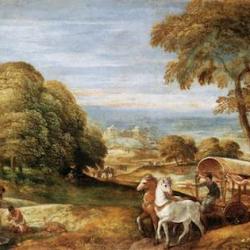Paul’s visit to Athens is nestled in the middle of a narrative sequence describing Paul’s missionary journey. When Paul and Barnabas part ways because of their dispute over John Mark (15:36-39), Paul continues his missionary work with Silas. Together with Timothy, they visit Philippi (16:6-40), Thessalonica (17:1-9) and Berea (17:10-15). In the first two towns, they meet violent resistance, while in the third they are given a careful hearing by the “noble” Bereans. Paul and Silas late preach together in Corinth (18:1-11).
Paul has to flee from Berea because the Thessalonian Jews chase him there (17:13), and he leaves Silas and Timothy behind at Berea while he travels on to Athens. In general, the chapters are structured in a simple chiasm:
A. Paul, Silas, Timothy.
B. Paul alone in Athens
A’. Paul, Silas, Timothy.
The B section, Acts 17:16-34, is itself chiastically arranged:
A. Provoked by idols, Paul engages the Jews and Gentiles in Athens, vv 16-17
B. The Philosophers question him and invite him to the Areopagus, vv 18-21
C. Paul’s sermon, vv 22-31
c1. Worship in ignorance, vv 22-23
c2. God is Creator and doesn’t dwell in temples nor served by human hands, vv 24-25
c3. God made human beings from one, and arranged the world for men to find him, vv 26-28
c2′. Since we are offspring of God, we ought not worship gold, silver, stone, v 29
c1′. The time of ignorance is over, and God is ready to judge the oikoumene, having raised Jesus, vv 30-31
B’. Philosophers scoff at resurrection and Paul leaves Areopagus, vv 32-33
A’. Some believe, turning from their idols, v 34
At the center of this structure is Paul’s speech on the Areopagus, and at the center of this central discourse is the declaration that God determined the times and boundaries of the nations to lead them all to seek Him. The central declaration is that God is near to all, because in Him all live, move, and have their being.










